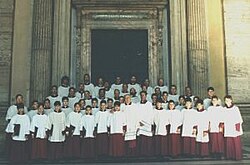Papal Choir of the Sistine Chapel
| Papal Choir of the Sistine Chapel | |
|---|---|
| Seat: |
|
| Carrier: | Roman Curia |
| Founding: | around 600 |
| Founder: | Pope Gregory the Great |
| Head : | Marcos Pavan (acting) |
| Voices : | 60 (SATB) |
| Website : | www.cappellamusicalepontificia.va |
The Papal Choir of the Sistine Chapel (officially: Cappella Musicale Pontificia Sistina ) is the choir that takes on the musical design at papal liturgical celebrations, mostly in St. Peter's Basilica , but often also in the building of the same name . Liturgical celebrations not presided over by the Pope , on the other hand , are given music by the choir of St. Peter's Basilica, the Cappella Giulia .
history
The choir was founded as Schola cantorum by Pope Gregory I (590 to 604). From then to the present day, popes have updated the statutes several times. It is an institution of the Roman Curia .
Notation in Pierer's Universal Lexicon

In Pierer's Universal Lexicon from 1892, under the heading " Sistine Chapel ", it says:
"Sistine Chapel (Italian: Cappella Sistina), the Pope's house chapel in the Vatican, built in 1473 under Pope Sixtus IV by the Florentine Giovanni de 'Dolci, rectangular, 48 m long 15 m wide a. 18 m high, with frescoes v. Michelangelo (Creation, Fall, Flood, Prophets, Sibyls. The Last Judgment) u. twelve wall paintings v. Pietro Perugino, Sandro Botticelli , Cosimo Rosselli, Luca Singnorelli, Domenico Ghirlandaio.
- SK is also called the pope. Singing choir, here, u. he only sings in a cappella style. All singers who are headed by a Kapellmeister or Primicerius (elected from the college of singers since 1586) are priests and others. papal Chaplains (approx. 30). The SK was v. Pope Gregory the Great (590-604) founded; the current statutes come from Pope Paul III. (1545); it received its constitution under Sixtus V (1585–90). Bes. her noble vocal performance, which is distinguished by artistic mezza voce , is praised. "
Members
The choir masters included well-known composers such as Giovanni Pierluigi da Palestrina . The singers also included well-known musicians such as Josquin Desprez , Cristóbal de Morales , Jakob Arcadelt and Gregorio Allegri . Monsignor Massimo Palombella was in charge of the choir from October 2010 to July 2019 .
Castrati as choir singers
As early as late antiquity , and later especially in the Baroque , many boys in Italy were castrated before puberty with the aim of maintaining their high soprano or alto voice and enabling them to pursue a career as successful church or opera singers . Many castrati were also employed as papal singers. Among them were some famous singers like Loreto Vittori , Marc'Antonio Pasqualini , Siface or Farfallino .
Despite papal bans, boys were castrated until the middle of the 19th century and found, among other things, a life as singers in the Sistine Choir, including a. a. Domenico Mustafà , who was also the director of the choir. It was not until November 22nd, 1903, when Pope Pius X wrote in his Motu Proprio Tra le sollecitudini (on church music ) that only uncastrated boys should be used for the cast of soprano and alto voices, and thus practically forbade the employment of castrati in church choirs. Only this strict prohibition removed the only remaining basis for the practice of castration to promote a singing career. In 1922, Alessandro Moreschi , the last castrato of the papal chapel and the only one of whom audio documents have survived, died.
literature
- Bernhard Janz: Cappella Sistina. In: Ludwig Finscher (Hrsg.): The music in past and present . Second edition, factual part, volume 2 (Bolero - Encyclopedie). Bärenreiter / Metzler, Kassel et al. 1995, ISBN 3-7618-1103-9 ( online edition , subscription required for full access)
Web links
- Papal Choir of the Sistine Chapel
- Address by Benedict XVI. to the choir of the papal "Cappella Sistina" of December 20, 2005 at www.vatican.va
- Official site (Italian)
Individual evidence
- ↑ Uta Ranke-Heinemann: Eunuchs for the kingdom of heaven . Complete paperback edition, 5th edition, Droemer Knaur, Munich 1996, ISBN 3-426-04079-4 , p. 263.
- ^ Motu Proprio Tra le sollecitudini del sommo Pontefice Pio X Sulla musica sacra. November 22, 1903 Paragraph V: “The Singers”, Section 13. On: www.vatican.va (Italian); German translation at kathpedia.com
